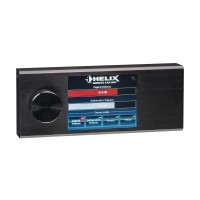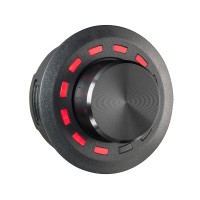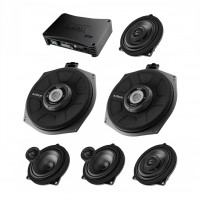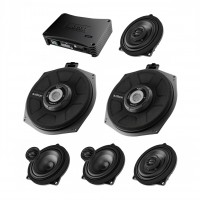Amplifier with DSP processor Helix P Six DSP Ultimate
More about the product
- Use our consulting room
- You can return the goods to us within 14 days
- Try the product at our store
Amplifier with DSP processor Helix P Six DSP Ultimate
State-of-the-art technology and TwinDSP performance for the ultimate high-resolution audio experience
The P Six DSP Ultimate features two of the most powerful 64-bit audio signal processors from Analog Devices. The incredible processing power of 2.4 billion MAC operations per second, combined with a high sampling rate of 96 kHz and a resulting audio bandwidth of over 40 kHz, as well as BurrBrown A/D and D/A signal converters, ensure excellent high-resolution audio. In addition, the complete audio signal path has been optimized down to the last detail, including a new, more powerful power supply.
ACO - Advanced 32 Bit CoProcessor Platform
The P Six DSP Ultimate is equipped with our own 32-bit ACO platform, which not only takes over all control tasks ultra-fast, but also handles a lot of audio functions: Now fantastic sound effects such as Augmented Bass Processing or Real Center are implemented as well as channel-separated Input EQ including Input Signal Analyzer (ISA) for easy analysis and compensation of the input signals of OE radios that already include sound settings from the factory.
Optimal connectivity and flexibility
With a wide range of inputs and outputs (6x high level, 6x RCA, 1x optical SPDIF, 1x coaxial SPDIF, 1x HEC slot, 4x line output and 1x optical output), the P Six DSP Ultimate offers everything for easy adaptation to existing factory radios or multi-channel OE sound systems. In addition, the extended voltage range of up to 32 V RMS allows combination with almost any analog signal source imaginable, even with high-performance OE amplifiers. In addition, the integration of an optical digital output enables a completely digital signal chain with downstream amplifiers such as the P ONE MK2 or P TWO MK2. Last but not least, VCP (Virtual Channel Processing) is now included for flexible and easy configuration of even highly complex sound systems.
DSP PC-Tool 5 feat. TuneEQ - Powerful functions for a perfect sound experience
Of course, the P Six DSP Ultimate can be easily configured with our new, professional and exceptionally intuitive DSP PC-Tool 5. The well-known, numerous setting options with extensive sound processing functions leave nothing to be desired and guarantee extremely accurate sound settings even in the most difficult conditions. And with our new easy-to-use TuneEQ function for automatic frequency response correction, you'll also save a lot of time optimizing your sound.
The main features of the P Six DSP Ultimate amplifier
- Output power up to 285 W RMS per channel into 2 Ω.
- Class D Ultra HD concept - combines the superior sound quality of Class AB technology with the advantages of Class D amplifiers.
- TwinDSP Power - Two extremely powerful "fixed point" audio DSPs with 64Bit resolution and 2.4 billion MAC operations per second.
- A/D and D/A signal converters from BurrBrown.
- VCP (Virtual Channel Processing) enables even more flexible configuration for highly complex audio systems.
- ACO - Advanced CoProcessor for extended feature set.
- ISA (Input Signal Analyzer) and InputEQ for easy analysis and compensation of input signals.
- Proprietary TuneEQ function for automatic adjustment of output equalizers.
- SFX (DSP Sound Effects) – extended bass processing, RealCenter & Co.
- High-performance 6-channel high-level input with input sensitivity up to 32 V RMS and ADEP circuit.3.
- Optical (max. 96 kHz) and coaxial (max. 192 kHz) digital input in SPDIF format.
- Four RCA / RCA outputs with a max. output voltage of 3V.
- Optical digital output in SPDIF format (96 kHz).
- Compact, perspective Smart Control Port (SCP) for connecting remote controls and accessories.
- HEC slot for system expansion such as Bluetooth® HD Audio Streaming, High Resolution Audio Streaming via USB, etc.
- Automatic remote switch.
- Start-Stop option up to 6V supply voltage.
- Very compact design with low heat dissipation due to exceptional efficiency.
Class D Ultra HD amplifier technology
Compared to conventional Class D amplifiers, this concept achieves an extended frequency response of over 40kHz combined with reduced distortion thanks to an advanced integrated feedback design. Ultra HD Class D achieves excellent sound quality "like Class AB" combined with the efficiency of a Class D amplifier.ACO - Advanced 32-bit CoProcessor
The HELIX V EIGHT DSP MK2 contains an extremely powerful 32-bit CoProcessor of the latest generation for all monitoring and communication tasks, internally and externally. Unlike the generation of 8-bit predecessors, this MCU achieves much higher speed with regard to switching settings and data communication with our DSP PC-Tool software. Another significant advantage is the integrated native CoProcessor bootloader. It allows software updates of all components of the integrated DSP in order to adapt the ADEP.3 circuit controlled by microcontrollers, for example, to the future requirements of the diagnostic system of production radios or if the device is expanded with additional interfaces. In addition, thanks to the new flash memory, the ACO offers 10 regular memory settings instead of the usual two.
ADEP high level smart input.3
Modern factory-installed car radios include sophisticated diagnostic options for connected speakers. Especially the latest generation of car radios are equipped with additional monitoring functions, so error messages and loss of specific functions (eg fader functions) often appear if the amplifier is connected - but not with the V EIGHT DSP MK2. The new ADEP.3 (Advanced Diagnostics Error Protection, 3rd generation) circuit avoids these problems without unnecessarily loading the OE radio speaker outputs at high volumes.
Start-Stop option
The switching power supply of the HELIX V EIGHT DSP MK2 ensures a constant internal supply voltage, even if the battery voltage drops to 6 V during engine cranking.
Power saving mode
Power saving mode is part of the basic settings. It allows to significantly reduce the power consumption of the amplifiers that are connected to the HELIX V EIGHT DSP MK2 when no input signal is present for more than 60 seconds. Please note that in many modern cars with "CAN" or other internal bus structure, the radio may remain "invisibly" on for up to 45 minutes even after locking and exiting the vehicle! When "Power Save Mode" is active, the remote output and connected amplifiers will be turned off. When a music signal is applied, the V8 EST DSP MK2 activates the remote output within one second. It is possible to change the shutdown time to 60 seconds or completely disable the "Energy Saving Mode" using the DSP PC-Tool software.
| Catalog number | P SIX DSP ULTIMATE |
| Brand | Helix |
| Links | Official web presentation |
| Number of amplifier channelsAmplifiers are divided into: - Monoblocks - 2-channel - 3-channel - 4-channel - 5-channel - 6-channel - multi-channel Each channel is used to power one speaker for the coaxial type, or one side if they are component speakers. Monoblock type amplifiers are mainly used for subwoofers. 2-channel are suitable for both subwoofers and, for example, the front pair of speakers in a car. 3-channel is used for front or rear speakers + subwoofer. 4-channel are used for front + rear speakers or 1 pair of speakers + subwoofer. 6 or 5-channel are used for 2 pairs of speakers + subwoofer, most often. Bridging means connecting the amplifier to a bridge, using the + pole from one channel and the - pole from the other channel. In most cases this is shown as "BRIDGED" on the amplifier. | 6 |
| Energy class of the amplifierAmplifiers are divided into two basic classes: analog and digital . Analog amplifiers (A/B) have higher consumption requirements, but usually have a more natural sound. Digital amplifiers (D) have significantly lower consumption and higher efficiency, but the sound may not be as faithful as with classic analog amplifiers. | Ultra HD Class D |
| RMS power into 4 ΩRMS power when loading speakers or subwoofer at 4 Ω. RMS power is the constant power of the amplifier and is one of the most important parameters when choosing an amplifier. | 6 x 120W |
| RMS power into 2 ΩRMS power when loading speakers or subwoofer at 2 Ω. RMS power is the constant power of the amplifier and is one of the most important parameters when choosing an amplifier. | Channel CF: 4 x 230 W |
| Inputs | 6 x RCA, 6 x Hi-level, 1 x optical SPDIF, 1 x coaxial SPDIF |
| Outputs | 4 x RCA, 1 x optical, 6 x speaker |
| Integrated DSP processor | Yes |
| Number of DSP processor channels | 12 |
| Frequency rangeThe ability of the amplifier to reproduce the signal from the lowest frequency to the highest = faithfully reproduce the sound in a specific frequency band. Professionally: In the frequency range from 40 to 16,000 Hz, the vast majority of fundamental and overtones (harmonics) of all musical instruments are found. We are interested in the course of the radiated sound pressure in this range of frequencies when the loudspeaker system is supplied with constant power. We call this course the frequency characteristic, which tells us the level of radiated sound pressure in decibels (dB) depending on the frequency. The frequency characteristic of a speaker or speaker system can be expressed most succinctly with a graph. Mostly, however, the frequency characteristic is indicated by indicating the maximum tolerance of the sound pressure in the given frequency range, e.g. 50 to 15,000 Hz -+ 6 dB. Since the frequency characteristics of loudspeakers and systems in general are quite uneven, some manufacturers do not even specify this maximum tolerance of sound pressure in decibels in their catalogs for reasons of prestige. Data impoverished in this way is unfortunately worthless. What is valid is that the manufacturer offers a speaker system with a frequency range of 30 to 20,000 Hz, if he is worried about stating the maximum unevenness of the sound pressure in this range, because he can have a tolerance of, for example, +- 20 dB. The unevenness or undulation of the frequency curve in good speaker systems for high-quality music performance should not exceed +-3 dB in the 80 to 12,000 Hz band and +-6 dB in the 40 to 16,000 Hz band. Greater unevenness already depletes or emphasizes certain tonal areas, which can cause audible or even disturbing distortion. The proportion between fundamental tones and higher harmonics also changes, thereby changing the color of the sound, and individual musical instruments as well as the entire musical image sound unnatural. | 10 - 44000 Hz |
| Harmonic Distortion (THD)Total harmonic distortion indicates how much the input signal is distorted in the amplifier. Distortions appear as overtones contained in the output signal. The proportion of originally absent parts of the signal is given as a percentage, typical values are between 0.001% and 0.5%. Distortion is measured in their power band. If it exceeds the limit of 0.7% from a certain power, it is the value of the output power of the given amplifier, from which it no longer plays without distortion and from which the distortion usually increases steeply, so that no further increase in power can be counted on. The lower the value, the better. | < 0.004% |
| Signal-to-noise ratioThe signal-to-noise ratio means that the output signal always contains noise. The signal-to-noise ratio expresses how much of this noise is compared to the useful signal. The so-called A value is given, which does not take deep and very high frequencies into account. This corresponds to the characteristic of human hearing, which is not so sensitive to deep frequencies, especially below 1 kHz. The higher the value, the better the amplifier is. | 108 dB |
| Damping factorDF - Damping Factor . It is the ratio of the load (repro + cables, crossover, etc.) to the internal resistance of the amplifier. The bigger the DF, the more controlled the bass. Amplifiers with a lower DF tend to hum. Subwoofers with a higher Q in the bass reflex and sometimes in the enclosure will also cause humming. | > 100 |
| High level inputsThe high-level input on the amplifier allows connection directly to the existing speakers in the car without additional purchase of an external high/low adapter. Important equipment in the case of installing an amplifier on an original car radio. | Yes |
| Automatic on and offThis function allows you to automatically switch on the amplifier. | Yes |
| Socket input terminalsFerrule terminals allow better wiring contact to the amplifier. It is also a more secure form of terminals. If you are tightening the sleeve terminals, we recommend retightening them after 1 day, as the connected cable gradually compresses. | Yes |
| Remote control included in the packageSome models of amplifiers also come with wired remote controls in the package, which on one side plug into the amplifier and on the other side you have a potentiometer that you can place anywhere in the cabin. A common place to place the remote control is under the steering wheel. The advantage is the regulation of power, and therefore volume, depending on driving conditions and the mood of the crew in the car. | No |
| Input for wired remote controlIf the amplifier has a remote control input. | Yes |
| The value of the fuses on the amplifierFrom the value of the fuses on the amplifier, you can get a true picture of the real performance of the amplifier. | 3 x 20A |
| Dimensions of the amplifier | 50 x 260 x 190 mm |































